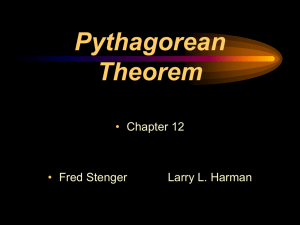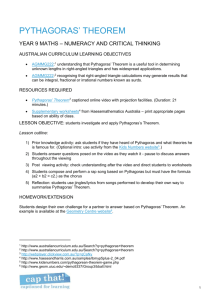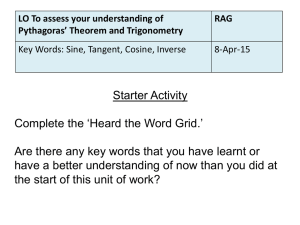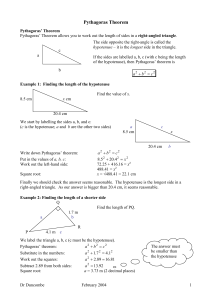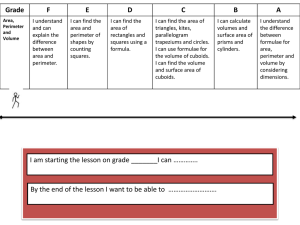File
advertisement
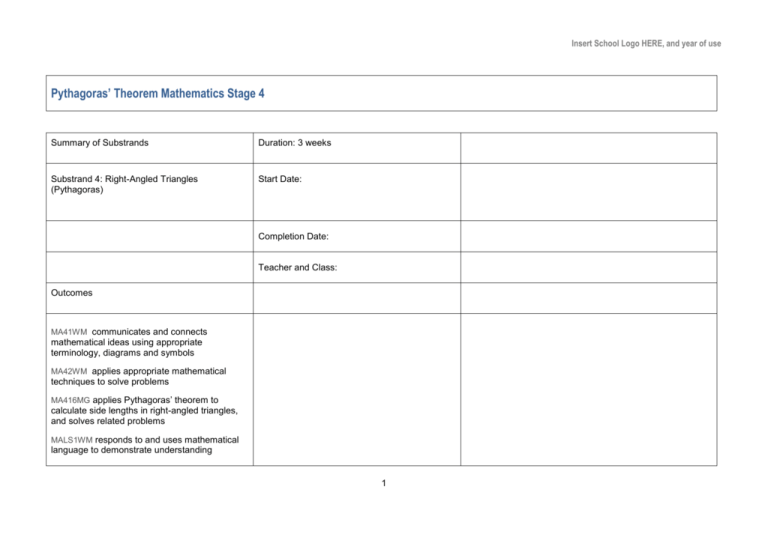
Insert School Logo HERE, and year of use Pythagoras’ Theorem Mathematics Stage 4 Summary of Substrands Duration: 3 weeks Substrand 4: Right-Angled Triangles (Pythagoras) Start Date: Completion Date: Teacher and Class: Outcomes › MA41WM communicates and connects mathematical ideas using appropriate terminology, diagrams and symbols › MA42WM applies appropriate mathematical techniques to solve problems › MA416MG applies Pythagoras’ theorem to calculate side lengths in right-angled triangles, and solves related problems › MALS1WM responds to and uses mathematical language to demonstrate understanding 1 Insert School Logo HERE, and year of use › MALS2WM applies mathematical strategies to solve problems › MALS3WM uses reasoning to recognise mathematical relationships › MALS30MG recognises, matches and sorts three- dimensional objects and/or two-dimensional shapes › MALS31MG identifies the features of three- dimensional objects and/or two-dimensional shapes and applies these in a range of contexts Overview Key Words Throughout this unit of work student will investigate Pythagoras’ theorem and its application to solving simple problems involving rightangle triangles. Exact and approximate answers, surd, square root, squared, converse, triad, irrational, length, perimeter, area, hypotenuse, opposite, adjacent,side, right-angle, accuracy, vertical, horizontal, incline, Rego Suggested Assessment ● Content Teaching, learning and assessment Stage 4 - Right-Angled Triangles (Pythagoras) Pre-Assessment Students: Find squares and square roots, using a calculator and noncalculator techniques. Begin with square numbers Investigate Pythagoras' theorem and its application to solving simple problems involving right-angled triangles (ACMMG222) ● identify the hypotenuse as the longest side in any right-angled triangle and also as the side Resources Before beginning this topic, students will need to be able to: Round to a predetermined number of decimal places, with the understanding that their solution is now an approximation of the full solution. Label and identify parts of a triangle using mathematical Sides of a right-angle triangle 2 Insert School Logo HERE, and year of use opposite the right angle conventions ● establish the relationship between the lengths of the sides of a right-angled triangle in practical ways, including with ● the use of digital technologies ● ● describe the relationship between the sides of a rightangled triangle (Communicating) ● Basic properties of a right-angled triangle http://www.wisconline.com/Objects/ViewObject. aspx?ID=TMH401 Identify the hypotenuse as always opposite the right angle using a number of triangles of different orientations Physically measure the distances of all sides of a number of right angles triangles, with the intention of the students “discovering” that the hypotenuse is always the longest side and its relative position to the right angle Adjustment: For less able students use 2 coloured highlighters to represent hypotenuse and right angle in one colour and other sides in the other. Water Activity Complete activity where squares on sides are cut up to show that the smaller two side have the same area as the larger side (hypotenuse) http://www.youtube.com/watch? v=CAkMUdeB06o Adjustment: lower ability students may benefit from a 1cm grid division on the squares, so they can cut up individually and move to hypotenuse. Showing Pythagoras theorem visually More able students can approach this using tangrams http://www.pbs.org/wgbh/nova/p roof/puzzle/theorem.html Discussion to follow this activity asking questions such as What does this show you in relation to sides? ● Watch the You Tube clip of Pythagoras being demonstrated with water ● Use computer animations to demonstrate the theorem At this stage the teacher must formalize the theorem. It is important that c2 = a2 + b2 is not the only format given to students ● use Pythagoras' theorem to find the length of an unknown side in a Finding the Hypotenuse http://www.mathsisfun.com/pyth agoras.html http://www.brainingcamp.com/re sources/math/pythagoreanformula/lesson.php Changing side lengths 3 Insert School Logo HERE, and year of use right-angled triangle ➢ explain why the negative solution of the relevant quadratic equation is not feasible when solving problems involving Pythagoras' theorem (Communicating, Reasoning) Initially only find the length of the hypotenuse. It is important for students to be very proficient at this before proceeding to finding a shorter side. Begin with examples that lead to whole number answers. During the completion of this section it is worthwhile to stress that the longest side is the hypotenuse and so your answer will be the biggest. Proceed to examples with answers that are not exact square roots interactive Scootle L6559 Worked examples http://www.mathwarehouse.com/ geometry/triangles/how-to-usethe-pythagorean-theorem.php Finding the shorter side Revise solution of equations. Ask: If the hypotenuse is 10m, and one of the other sides is 6m long, how would you find the length of the unknown side? Some students will use equation solving techniques whilst others will develop the “subtraction” method. This needs to be consolidated through extensive practice in a variety of orientations. (triangles given) ● write answers to a specified or sensible level of accuracy, using an 'approximately equals' sign, ie or Adjustment: Lower ability students may only be able to work with exact answers, as errors may occur with rounding etc. Discuss sensible answers and levels of accuracy. This will need to be discussed again once problems have been solved and the context of their answers. Review “rounding” rules Investigate the concept of irrational numbers (ACMNA186) ● use technology to explore decimal approximations of surds ➢ recognise that surds can be represented by decimals that are neither terminating nor have a repeating pattern Practical application problems http://www.mathsteacher.com.a 4 Insert School Logo HERE, and year of use (Communicating) ● ● solve a variety of practical problems involving Pythagoras' theorem, approximating the answer as a decimal solve a variety of practical problems involving Pythagoras' theorem, giving exact answers (ie as surds where appropriate), eg ➢ apply Pythagoras' theorem to solve problems involving the perimeters and areas of plane shapes (Problem Solving) u/year10/ch14_measurement/01 _pythag/18pythag.htm View SCOOTLE S4693 video on how the Egyptians built the pyramids so accurately. Follow with a discussion of where else Pythagoras can be used practical applications such as building, orienteering, navigation etc. A variety of real life problems should be investigated. Adjustment: Lower ability level students to stay with 2D problems whilst more able may progress to 3D problems Practical applications should be extended to find unknown sides for perimeter and area of plane shapes http://voyager.dvc.edu/~lmonth/ PreAlg/lesson51student.pdf http://www.regentsprep.org/Reg ents/math/ALGEBRA/AT1/PracP yth.htm Lessons, Interactive, Questions and Application of Pythagoras http://www.brainingcamp.com/re sources/math/pythagoreanformula/ http://www.bbc.co.uk/schools/gc sebitesize/maths/geometry/pyth agorastheoremact.shtml Applying Pythagoras’ theorem to decode a puzzle http://www.themathlab.com/Alge bra/pythagorean%20theorem%2 0intro%20to%20trig/pythagtest.h tm ● identify a Pythagorean triad as a set of three numbers such that the sum of the squares of the first two equals the square of the third ● use the converse of Pythagoras' theorem to establish whether a Triads Begin with 3,4,5 triad . Set out as follows e.g. 3,4,5 LHS = 52 = 25 RHS = 32 + 42 = 9 + 16 = 25 5 Patterns in triads and creating triads http://www.maths.surrey.ac.uk/h ostedsites/R.Knott/Pythag/pythag.html #moretriples Insert School Logo HERE, and year of use triangle has a right angle LHS = RHS Therefore this is a Pythagorean Triad Ensure examples used include non triads. e.g. 3,4,6 LHS = 62 RHS = 32 + 42 = 36 = 9 + 16 = 25 LHS ≠ RHS Therefore this is not a Pythagorean Triad Adjustment: More able students can investigate patterns in triads and how to create a triad Use the format as set up above to illustrate the converse Evaluation 6

